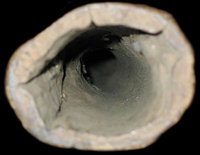Didgeridoo
|
|
The didgeridoo (or didjeridu) is a unique wind instrument of the Australian Aborigines of northern Australia. It is sometimes described as a natural wooden trumpet or "drone pipe". Musicologists classify it as an aerophone.
There are no reliable sources stating the didgeridoo's exact age, though it is commonly claimed to be the world's oldest wind instrument. Archaeological studies of rock art in northern Australia suggests that the Aboriginal people of the Kakadu region have been using the didgeridoo since about 1500 years ago, based on dating of paintings on cave walls and shelters from this period.
"Didgeridoo" is usually considered to be an onomatopaoeic word of Western invention, but it has been suggested[1] (http://www.flinders.edu.au/news/articles/?fj09v13s02) that it may be derived from the Irish words d?e or d?e, meaning variously 'trumpeter; constant smoker, puffer; long-necked person, eavesdropper; hummer, crooner' and dubh, meaning 'black' (or duth, meaning 'native'). The earliest occurrences of the word in print include the Australian National Dictionary 1919, The Bulletin in 1924 and the writings of Herbert Basedow in 1926. There are numerous names for this instrument among the Aboriginal people of northern Australia, with "yirdaki" one of the better known words in modern Western society. "Yirdaki", also sometimes spelt "yidaki", refers to the specific type of instrument made and used by the Yolngu people of north-east Arnhem Land. This name is not a substitute for "didgeridoo". In Western Arnhem Land, you are more likely to hear of "mago", and again, this is a specific term not to be used loosely. There is a general consensus that it is a matter of etiquette to reserve tribal names for tribal instruments, though retailers and businesses have been quick to exploit these special names for generic tourist-oriented instruments.
A didgeridoo is usually cylindrical or conical in shape and can measure anywhere from 1 to 1.5 metres. Instruments shorter or longer than this are less common. Generally, the longer the instrument, the lower the pitch or key of the instrument. Keys from D to F# are the preferred pitch of traditional Aboriginal players.
| Contents |
Construction and Play

Authentic Aboriginal didgeridoos produced in traditionally-oriented communities in northern Australia are typically made from hardwoods especially various eucalyptus species that are endemic to the region. The main trunk of the tree is often harvested, though branches are sometimes used as well. Aboriginal craftsmen spend considerable time searching for a suitable tree to make into a didgeridoo. The difficult part is in finding a tree that has been suitably hollowed out by termites. If the hollow is too big or too small, it will make a poor quality instrument.
Didgeridoo_real_mouth.jpg
Didgeridoo_tourist_mouth.jpg
When a suitable tree is found and cut down, a length of the main trunk or a segment of a branch is removed that will become the didgeridoo. The bark is taken off, the ends trimmed, and some shaping of the exterior then results in a finished instrument. This instrument may be painted or left undecorated. A rim of beeswax may or may not be applied to the mouthpiece end.
The didgeridoo is played with continuously vibrating lips to produce the drone while using a special breathing technique called circular breathing. This requires breathing in through the nose whilst simultaneously expelling air out of the mouth using the tongue and cheeks. By use of this technique, a skilled player can replenish the air in his lungs, and with practice can sustain a note for as long as desired. Recordings exist of modern didgeridoo players playing continuously for more than forty minutes, and some currently unsubstantiated claims peg times over one hour.
Cultural Significance
Didgeridoo_dancing.jpg
Didgeridoo_ceremony.jpg
The didgeridoo is sometimes played as a solo instrument for recreational purposes, though more usually it accompanies dancing and singing in ceremonial rituals. For Aboriginal groups of northern Australia, the didgeridoo is an integral part of ceremonial life, as it accompanies singers and dancers in religious rituals. Pair sticks, sometimes called clapsticks, establish the beat for the songs during ceremonies. The rhythm of the didgeridoo and the beat of the clapsticks are precise, and these patterns have been handed down for generations upon generations. Only men play the didgeridoo and sing during ceremonial occasions, whilst both men and women may dance.
The Modern Didgeridoo Industry
Didgeridoos_tourist.jpg
Most didgeridoos found in shops are not authentic instruments. They are usually mass produced in factories or mass harvested in Australian forests, often by non-Aboriginal entrepreneurs but also sometimes by Aboriginal people. There are also didgeridoos that are made from plastic, leather, glass, agave, yucca and other materials. For a cheap and simple didgeridoo, a length of PVC pipe makes an ideal beginner's instruments. If you want to learn or play on a real instrument, be careful of retailers who make claims of authenticity... more likely than not, you are getting a fake.


